Key Takeaways:
- Russia: Ukraine’s Main Military Intelligence Directorate reported that elements of Lebanese Hezbollah and the IRGC are training Russian drone operators at the Shayrat Air Base in Syria.
- Northern Gaza Strip: The Palestinian Mujahideen Movement stated that it reestablished contact with its “combat units” in southwestern Gaza City.
- Southern Gaza Strip: Israeli forces conducted an overnight raid to rescue Hamas-held hostages in Rafah.
- West Bank: Israeli forces clashed with Palestinian fighters two times.
- Southern Lebanon and Golan Heights: Lebanese Hezbollah conducted seven attacks from southern Lebanon into northern Israel.
- Iraq: The Iraqi Parliament discussed the removal of US-led international coalition forces from Iraq in a session.
- Yemen: The Houthis launched at least two anti-ship missiles targeting a Greek-owned, Marshall Islands-flagged commercial vessel carrying Brazilian corn to Iran.
- Iran: Iranian Foreign Affairs Minister Hossein Amir Abdollahian is conducting a regional tour and politically coordinating with senior Axis of Resistance leaders in Lebanon, Syria, and Qatar.
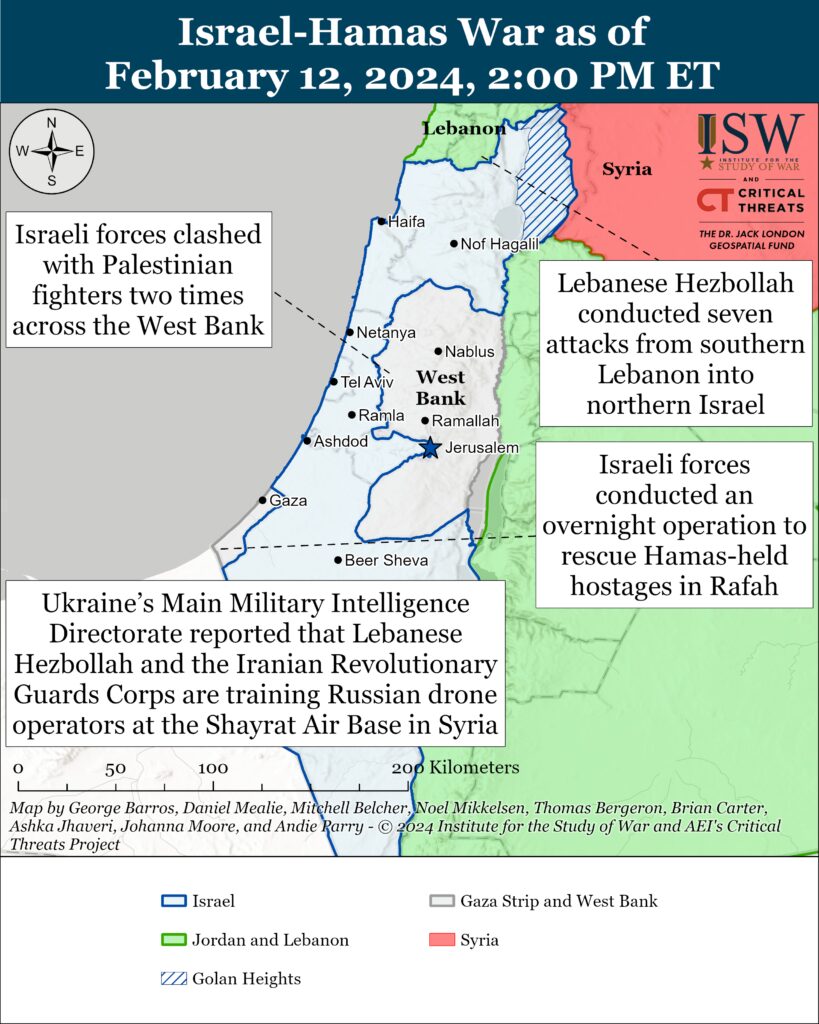
Gaza Strip
Axis of Resistance campaign objectives:
Erode the will of the Israeli political establishment and public to launch and sustain a major ground operation into the Gaza Strip
Degrade IDF material and morale around the Gaza Strip.The Palestinian Mujahideen Movement stated that it reestablished contact with its “combat units” in southwestern Gaza City on February 12.[v] The militia fighters reported that they detonated a house-borne improvised explosive device targeting Israeli forces. The Palestinian Mujahideen Movement is a Palestinian faction aligned with Hamas and has expressed close ties with Iran.[vi] The inability of these fighters to communicate with higher headquarters indicates that their commanders may be unable to transmit orders to fighters that are engaged with Israeli forces.
Israeli forces clashed with Palestinian fighters in eastern Khan Younis on February 12. Most of the engagements between the IDF and Palestinian militias occurred in eastern Khan Younis. The Palestinian Islamic Jihad (PIJ) reported that its fighters conducted a complex ambush targeting Israeli forces in Maan, southeast of Khan Younis.[vii] Hamas and al Aqsa Martyrs’ Brigades fighters reported that their fighters conducted separate attacks targeting Israeli forces east of Khan Younis.[viii] The al Aqsa Martyrs’ Brigades is the self-proclaimed militant wing of Fatah. The Palestinian Mujahideen Movement and al Aqsa Martyrs’ Brigades fired a rocket-propelled grenade (RPG) targeting Israeli armor in a combined attack in Khan Younis.[ix]
Palestinian militias did not claim any attacks in western Khan Younis on February 12 for the first time since Israeli forces “expanded” ground operations there on January 22.[x] The IDF reported on February 11 that its 84th Givati Brigade (assigned to the 162nd Division) “deepened” the damage it inflicted on Hamas’ Western Khan Younis Battalion.[xi]
The IDF reported on February 11 that Israeli forces have operated in the Amal Hospital in western Khan Younis in recent days.[xii] The Palestinian Red Crescent Society reported that Israeli forces entered the hospital on February 9.[xiii] The IDF 84th Givati Brigade (assigned to the 162nd Division) and Israeli special operations forces (SOF) detained about 20 Palestinian fighters, including some Hamas fighters hiding in the hospital.[xiv] The IDF said that Israeli forces searched the hospital without firing weapons and without harming medical staff or patients. The IDF briefed its forces on the importance of preventing harm to civilians “in accordance with international law” before the 84th Givati Brigade and SOF entered the building.[xv] The Coordinator of Government Activities in the Territories (COGAT), a unit under the Israeli Defense Ministry, supported the distribution of dozens of oxygen cylinders to the hospital after the operation.[xvi]
Israeli forces conducted an overnight raid to rescue Hamas-held hostages in Rafah on February 12.[xvii] An IDF armored brigade and other Israeli security services used “highly sensitive and valuable intelligence” to launch the raid.[xviii] Israeli SOF rescued two Hamas-held hostages and exfiltrated them from the Gaza Strip.[xix] The operation marks the second time since October 7, 2023, that Israeli forces have successfully retrieved hostages from the Gaza Strip.[xx] The IDF Air Force provided air support to suppress the local Hamas battalion during the raid.[xxi] The Palestinian Red Crescent Society reported that Israeli airstrikes killed approximately 100 people.[xxii] The US State Department spokesperson said on February 12 that the United States does not view the Israeli airstrikes in Rafah as “the launch of a full-scale offensive.”[xxiii]
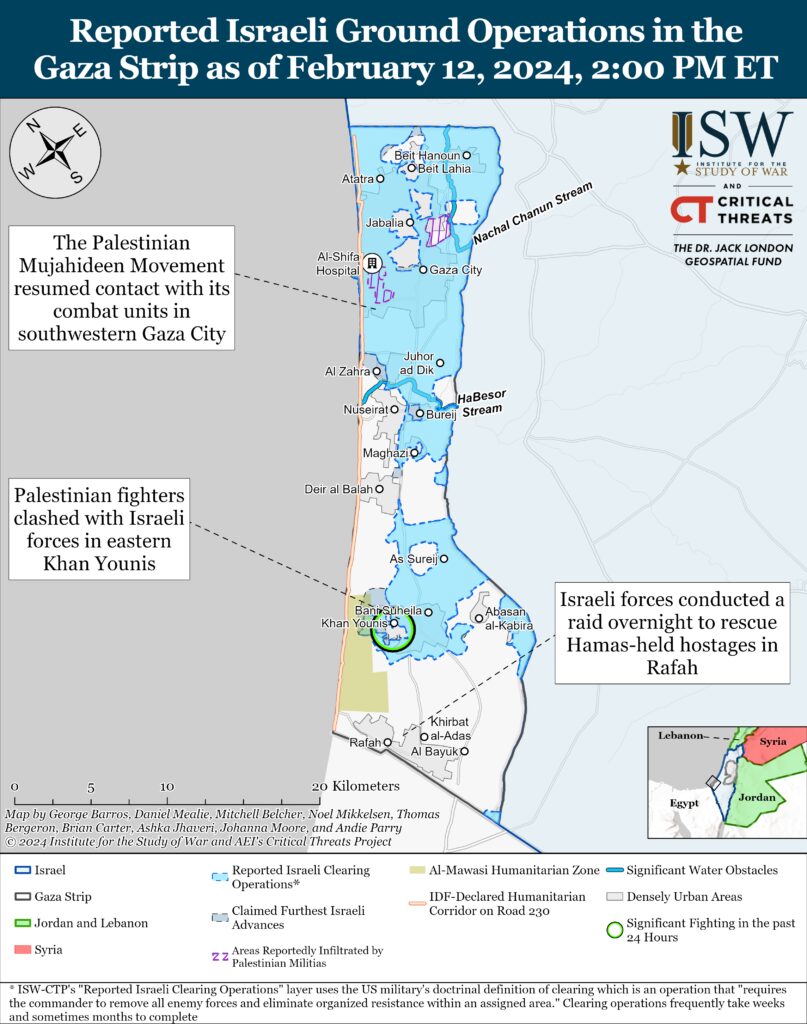
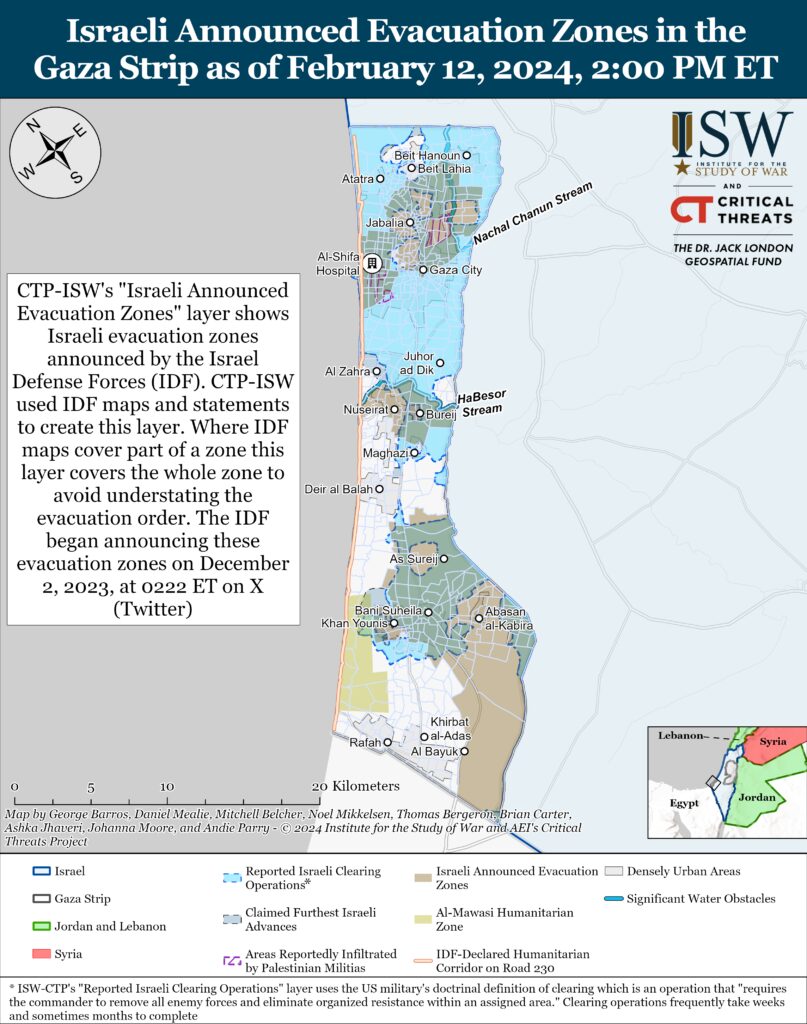
Two unspecified security officials told CNN on February 12 that Egypt has increased security along its border with the Gaza Strip as a “precautionary measure” in anticipation of an Israeli ground operation into Rafah.[xxiv] An eyewitness told CNN that the Egyptian Army reinforced checkpoints near the Rafah crossing and prepared roads in an unspecified manner for the deployment of tanks and military equipment. Egypt has added other fortifications to the border and deployed approximately 40 tanks and infantry fighting vehicles to the Rafah border crossing over the past two weeks.[xxv] Egypt has repeatedly expressed concern that an Israeli operation into Rafah could create a flow of Palestinian refugees into the Sinai Peninsula.[xxvi]
Israeli media reported that the IDF plans to release a report on alleged war crimes its service members have committed during the Israel-Hamas war.[xxvii] The IDF told Haaretz that the Israeli General Staff investigative team is working to ”examine reports and complaints of the violation of Israeli and international law in the course of the fighting.” The IDF said that the team is collecting data regarding various wartime events and that the investigation is in its initial stages.
The Palestinian Mujahideen Movement fired a rocket salvo from the Gaza Strip into southern Israel on February 12.[xxviii]
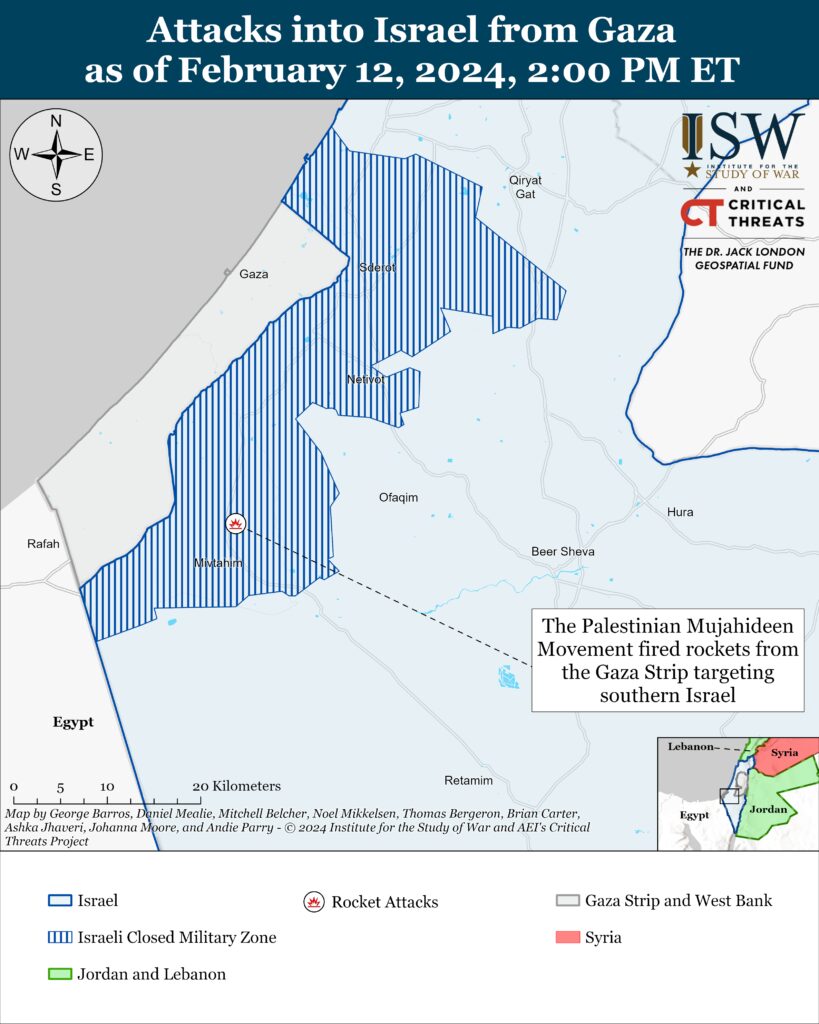
Recorded reports of attacks; CTP-ISW cannot independently verify impact.
West Bank
Axis of Resistance campaign objectives:
Draw IDF assets and resources toward the West Bank and fix them thereIsraeli forces clashed with Palestinian fighters two times across the West Bank on February 12.[xxix] The IDF killed on February 11 an unspecified fighter who attempted to stab an IDF soldier.[xxx] Israel police killed a separate attacker who also attempted to stab police officers.[xxxi] The IDF detained 17 wanted individuals across the West Bank overnight on February 11.[xxxii]

This map is not an exhaustive depiction of clashes and demonstrations in the West Bank.
Southern Lebanon and Golan Heights
Axis of Resistance campaign objectives:
Draw IDF assets and resources toward northern Israel and fix them there
Set conditions for successive campaigns into northern IsraelLebanese Hezbollah conducted seven attacks from southern Lebanon into northern Israel on February 12.[xxxiii] The IDF Air Force targeted a Hezbollah field commander, who was responsible for the Maroun al Ras region, in an airstrike near Bint Jbeil in southern Lebanon.[xxxiv] The commander survived the attack.[xxxv]
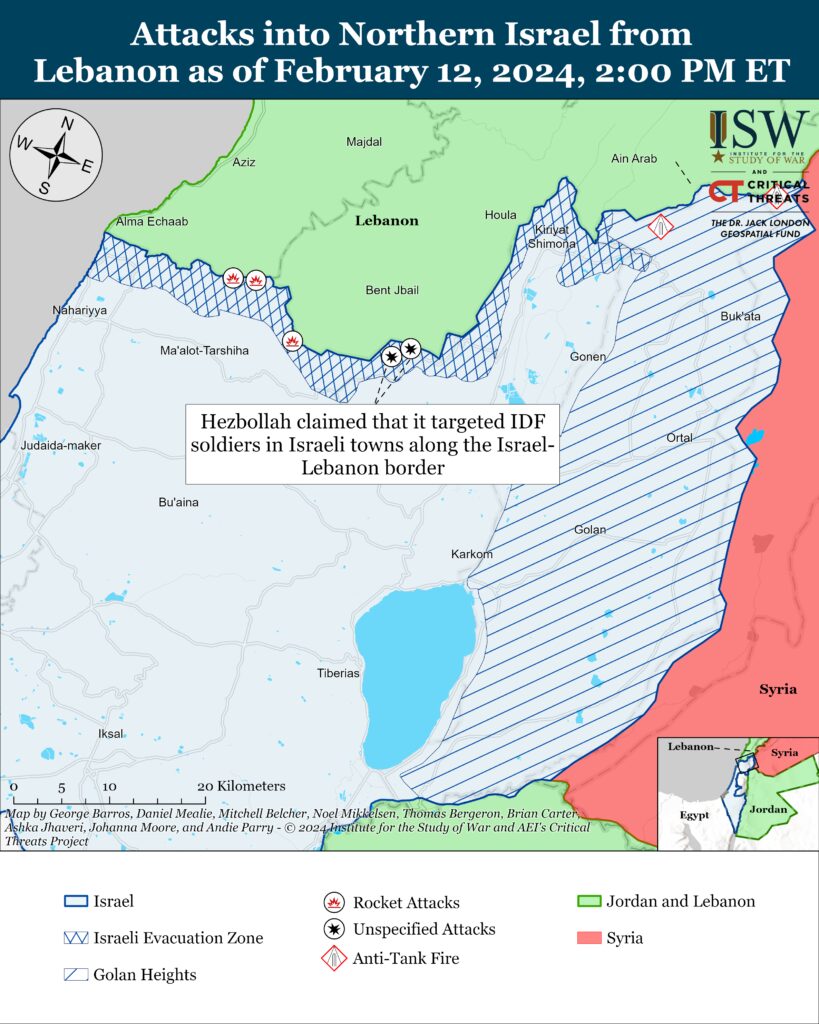
Recorded reports of attacks; CTP-ISW cannot independently verify impact.
Iran and Axis of Resistance
Axis of Resistance campaign objectives:
Demonstrate the capability and willingness of Iran and the Axis of Resistance to escalate against the United States and Israel on multiple fronts
Set conditions to fight a regional war on multiple frontsSenior Kataib Hezbollah official and Popular Mobilization Forces (PMF) Chief of Staff Abu Fadak (Abdul Aziz) al Mohammadawi stated that the Iraqi federal government and Islamic Resistance in Iraq will “coordinate” before any retaliation for the US strike that killed a Kataib Hezbollah commander in Baghdad on February 7.[xxxvi] Abu Fadak said that the “greatest revenge” for the US strike will be the expulsion of “foreign forces” from Iraq.[xxxvii]
Abu Fadak’s remarks are consistent with CTP-ISW’s assessment that the primary objective driving the Iranian-backed attacks on US forces is expelling these forces from the region. Iranian-backed militias are using Israeli operations as an excuse to attack US forces, when the actual objective of these attacks is to advance the long-standing Iranian effort to erode American influence in the Middle East. Iranian-backed militias have thus exploited the Israel-Hamas war to justify their attacks and partially obfuscate the core objective driving their escalation. Iran and its Axis of Resistance will almost certainly continue their decades-long effort to expel US forces from the Middle East regardless of whether there is a ceasefire agreement in the Israel-Hamas war.
The US force presence in Iraq aims to defeat ISIS at the invitation of the Iraqi federal government. CTP-ISW continue to assess that ISIS could resurge in Syria and then threaten Iraq 12 to 24 months after a US withdrawal.[xxxviii] The expulsion of US forces from Iraq would require the United States to end operations in Syria because US forces there rely on Iraqi bases for logistics and other support. The expulsion of US forces from Iraq would benefit ISIS by constraining US support to the Iraqi Security Forces (ISF), which still faces deficiencies in fire support, intelligence, and logistics.[xxxix]
The Iraqi Parliament discussed the removal of US-led international coalition forces from Iraq in a session on February 10. Over 100 parliamentarians called for an emergency parliamentary session following the February 7 US strike that killed a senior Kataib Hezbollah commander in Baghdad.[xl] Acting Iraqi Parliament Speaker Mohsen al Mandalawi ordered the formation of a parliamentary committee to “support” the Iraqi federal government’s negotiations with the United States to end the US-led international coalition’s mission in Iraq.[xli] Washington and Baghdad began talks about the status of the US-led coalition mission to defeat the Islamic State in Iraq and Syria on January 27.[xlii] Mandalawi also submitted a January 2024 draft law to the Parliamentary Security and Defense and Legal Committees.[xliii] The draft law calls for the removal of all foreign forces from Iraq.[xliv] The law would also require Iraqi Prime Minister Mohammad Shia al Sudani to author a report detailing how his administration would end the US presence in Iraq.[xlv]
Iranian-backed actors control the Parliamentary Security and Defense Committee, which is reviewing this draft law. Badr Organization member Abbas Zamili heads the committee. Zamili described the US presence in Iraq as a “threat to Iraqi security” and called for accelerating the removal of US forces on February 4.[xlvi] Mandalawi and PMF Chief of Staff Abu Fadak were with Zamili when he made these remarks.[xlvii] The Security and Defense Committee previously announced a draft resolution in December 2023 to expel US forces from Iraq.[xlviii]
Iranian-backed Iraqi parliamentarians accused Sunni and Kurdish factions of hampering the parliamentary efforts to expel the United States from Iraq. Parliamentarians affiliated with Kataib Hezbollah, Asaib Ahl al Haq, and the Badr Organization accused Sunni and Kurdish politicians of “boycotting” the February 10 parliamentary session discussing the removal of US-led international coalition forces.[xlix] A member of Asaib Ahl al Haq’s political wing called for Kurdistan Democratic Party Chairman Masoud Barzani and the leaders of other unspecified political blocs to be “punished for their support of the US presence in Iraq.”[l] National Progress Alliance member Nihal al Shammari denied that Sunni and Kurdish parliamentarians “boycotted” the February 10 session and claimed that only 60 members of the Shia Coordination Framework—a loose coalition of Iranian-backed political parties—attended the session.[li] The Shia Coordination Framework controls 138 out of 329 seats in Iraq’s parliament.[lii]
The Houthis launched at least two anti-ship missiles targeting a Greek-owned, Marshall Islands-flagged commercial vessel carrying Brazilian corn to Iran on February 12.[liii] The Houthis claimed that they targeted an “American” ship.[liv] The Greek shipping company that owns the vessel is listed publicly in the United States but is not US-owned.[lv]
Iranian Deputy Interior Minister for Security and Law Enforcement Majid Mir Ahmadi announced on February 10 that Iranian security forces killed an Islamic State member attempting to enter Iran from Iraq.[lvi] Iranian Law Enforcement Command (LEC) border guards recently arrested several unspecified individuals attempting to smuggle weapons from Iraq into Ilam Province on February 6.[lvii]
Unspecified individuals shot and killed two Basij members near the Zahedan-Bam railway in Sistan and Baluchistan Province on February 11.[lviii] The Basij is a regime-run, paramilitary organization responsible for civil defense and social control in Iran.[lix] This incident is part of an uptick in anti-regime militancy in southeastern Iran since December 2023. Jaish al Adl—a Balochi, Salafi-jihadi group operating on the Iranian border with Pakistan—has conducted at least five attacks targeting Iranian security personnel since December 2023.[lx] The Afghan branch of the Islamic State separately conducted a terrorist attack in Kerman Province in early January 2024, killing over 90 individuals.[lxi]
IRGC Commander Major General Hossein Salami claimed on February 12 that the IRGC Navy and Aerospace Force jointly launched a long-range ballistic missile from a warship for the first time.[lxii] Salami did not specify the type of missile launched or when it occurred.
Iranian Foreign Affairs Minister Hossein Amir Abdollahian is conducting a regional tour and politically coordinating with senior Axis of Resistance leaders in Lebanon, Syria, and Qatar. Abdollahian discussed developments in the Gaza Strip, southern Lebanon, and the “other fronts of the Axis of Resistance” during a meeting with Lebanese Hezbollah Secretary General Hassan Nasrallah in Beirut on February 10.[lxiii] Abdollahian also called on Palestinian militias to adopt a “unified position” on unspecified political initiatives to end the war.[lxiv] Abdollahian made this statement on February 10 during a meeting in Beirut with Palestinian Islamic Jihad Secretary General Ziyad al Nakhalah, senior Hamas official Osama Hamdan, and Popular Front for the Liberation of Palestine (PFLP) Deputy Secretary General Jamil Mazhar.[lxv] Abdollahian also met with the Lebanese prime minister, foreign affairs minister, and parliament speaker during his visit to Beirut.[lxvi] This trip marked Abdollahian’s third visit to Lebanon since the Israel-Hamas war began.[lxvii]
Abdollahian criticized US efforts to create “political plans” for the post-war Gaza Strip during a meeting with Syrian President Bashar al Assad in Damascus on February 11.[lxviii] Abdollahian emphasized that Palestinians and the leaders of Palestinian militias can and should “decide the management of the post-war Gaza Strip and West Bank.”[lxix] Abdollahian also met with Syrian Foreign Affairs Minister Faisal Mekdad in Damascus on February 11.[lxx]
Abdollahian traveled to Doha on February 12, marking his fifth visit to Qatar since the Israel-Hamas war began.[lxxi] Abdollahian could meet with Hamas Political Bureau Chairman Ismail Haniyeh, who is based in Doha. Abdollahian has previously met with Haniyeh and other Hamas officials during his recent visits to Doha.
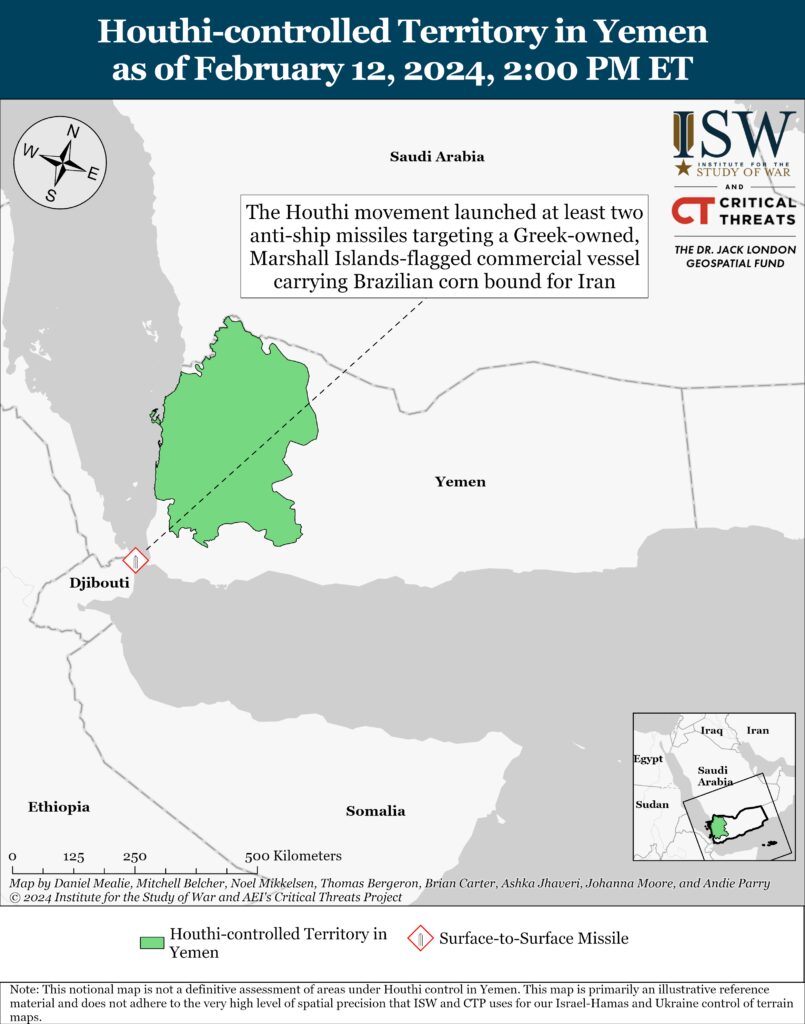
 Eurasia Press & News
Eurasia Press & News



